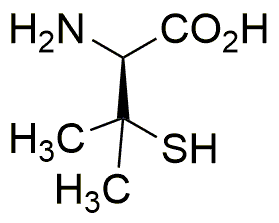D-Penicillamine is widely utilized in research focused on
- Rheumatoid Arthritis Treatment: It serves as a disease-modifying antirheumatic drug (DMARD), helping to reduce inflammation and slow disease progression in patients.
- Copper Overload Disorders: Effective in treating Wilson's disease, D-Penicillamine aids in the excretion of excess copper, preventing organ damage.
- Heavy Metal Detoxification: It acts as a chelating agent, binding to heavy metals like lead and mercury, facilitating their removal from the body.
- Kidney Stone Prevention: D-Penicillamine can help dissolve cystine stones, providing a non-surgical option for patients suffering from cystinuria.
- Research in Biochemistry: It is used in studies investigating protein interactions and enzyme functions due to its unique thiol group, which can modify protein structures.
General Information
Properties
Safety and Regulations
Applications
D-Penicillamine is widely utilized in research focused on
- Rheumatoid Arthritis Treatment: It serves as a disease-modifying antirheumatic drug (DMARD), helping to reduce inflammation and slow disease progression in patients.
- Copper Overload Disorders: Effective in treating Wilson's disease, D-Penicillamine aids in the excretion of excess copper, preventing organ damage.
- Heavy Metal Detoxification: It acts as a chelating agent, binding to heavy metals like lead and mercury, facilitating their removal from the body.
- Kidney Stone Prevention: D-Penicillamine can help dissolve cystine stones, providing a non-surgical option for patients suffering from cystinuria.
- Research in Biochemistry: It is used in studies investigating protein interactions and enzyme functions due to its unique thiol group, which can modify protein structures.
Documents
Safety Data Sheets (SDS)
The SDS provides comprehensive safety information on handling, storage, and disposal of the product.
Product Specification (PS)
The PS provides a comprehensive breakdown of the product’s properties, including chemical composition, physical state, purity, and storage requirements. It also details acceptable quality ranges and the product's intended applications.
Certificates of Analysis (COA)
Search for Certificates of Analysis (COA) by entering the products Lot Number. Lot and Batch Numbers can be found on a product’s label following the words ‘Lot’ or ‘Batch’.
*Catalog Number
*Lot Number
Certificates Of Origin (COO)
This COO confirms the country where the product was manufactured, and also details the materials and components used in it and whether it is derived from natural, synthetic, or other specific sources. This certificate may be required for customs, trade, and regulatory compliance.
*Catalog Number
*Lot Number
Safety Data Sheets (SDS)
The SDS provides comprehensive safety information on handling, storage, and disposal of the product.
DownloadProduct Specification (PS)
The PS provides a comprehensive breakdown of the product’s properties, including chemical composition, physical state, purity, and storage requirements. It also details acceptable quality ranges and the product's intended applications.
DownloadCertificates of Analysis (COA)
Search for Certificates of Analysis (COA) by entering the products Lot Number. Lot and Batch Numbers can be found on a product’s label following the words ‘Lot’ or ‘Batch’.
*Catalog Number
*Lot Number
Certificates Of Origin (COO)
This COO confirms the country where the product was manufactured, and also details the materials and components used in it and whether it is derived from natural, synthetic, or other specific sources. This certificate may be required for customs, trade, and regulatory compliance.


